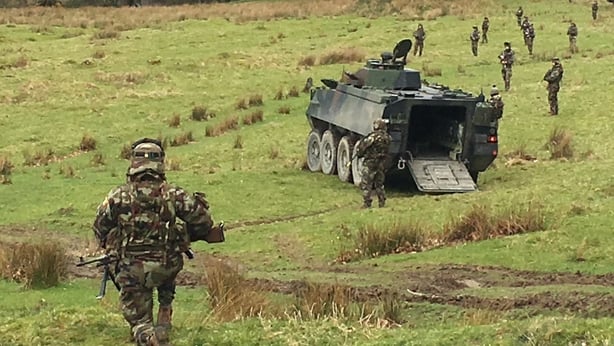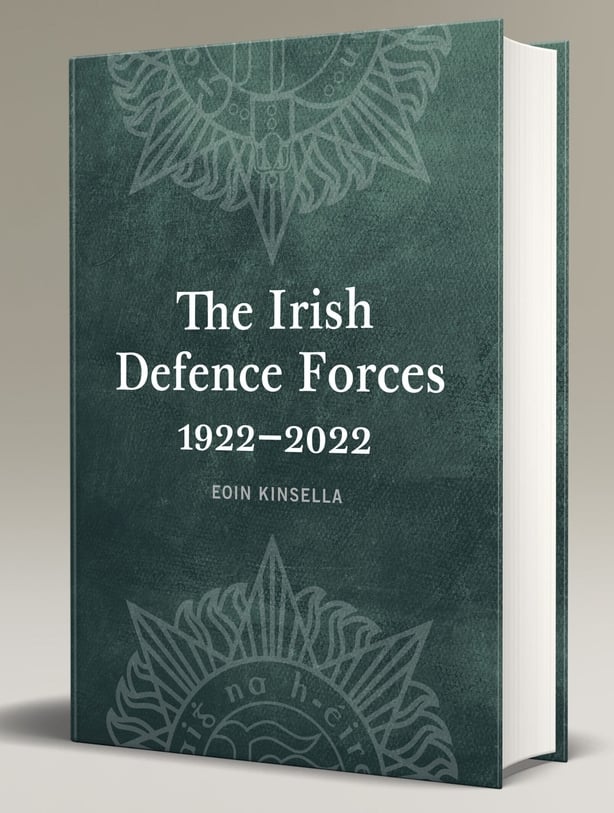David McCullagh reviews The Irish Defence Forces, 1922-2022, the new book by Eoin Kinsella exploring the landmark successes and achievements, struggles and missteps of the Defence Forces over the past century.
In publishing, as in military strategy, timing is everything. And this comprehensive, well-researched and lavishly illustrated history appears at a time when the Defence Forces are very much in the news – though not, unfortunately, for positive reasons.
The recent report of the Independent Review Group highlighted damning allegations of past and current misogyny and abuse against women soldiers, while the debate over the future of Irish defence policy, and the weakness of our current arrangements, is only beginning in earnest.
Dr Eoin Kinsella has done the Defence Services proud with this book, packed with fascinating photographs, documents and images of memorabilia, which, while not uncritical, highlights the importance of the Army, Naval Service and Air Corps to the State – starting, of course, with winning the Civil War.
Building the National Army in 1922 on the foundations of the IRA was a massive logistical challenge. Almost from scratch, Richard Mulcahy and his colleagues built a professional army, under pressure of looming conflict with former comrades who were now in the anti-Treaty IRA. The National Army had the advantage of steady supplies from Britain, but were also much better at the prosecution of a conventional war, quickly disrupting anti-Treaty hopes of holding the south of the country with innovative seaborne landings and co-ordinated assaults over land.
When the conflict degenerated into the guerrilla phase, however, there is a darker story, which Kinsella deals with in detail, highlighting the Army's use of 'intimidation and terror’, [possible link to piece on Owen O’Shea’s civil war in Kerry book?] and criticising Mulcahy’s ‘instinct to protect the National Army’s reputation’, which in the end backfired.
This played a part in the Army Crisis of 1924, when sections of the Army threatened to mutiny in protest at demobilisation; the Government responded weakly to the mutineers, but sacked senior Army officers and effectively forced Mulcahy to resign as Minister for Defence. While some officers were undoubtedly treated unjustly, and the affair contributed to growing civil service control over the military, it also showed that the Army would play no role in politics.
This was confirmed in 1932, when former GOC Eoin O’Duffy, at that time Garda Commissioner, sought support for a coup to prevent Fianna Fáil taking power. Chief of Staff Michael Brennan, backed by fellow officers and senior Cumanna na nGaedheal ministers, refused to contemplate such a move.
After the Civil War, the Cumann na nGaedheal Government which owed its existence to the Army showed little gratitude. Army strength, which reached a peak of 55,000 in April 1923 had fallen to just 5,000 a decade later; a Coastal and Marine Service established in 1923 was axed just a year later; the Air Corps narrowly avoided a similar fate, as senior officers and civil servants were ‘convinced that the greatest threat to the state lay internally, best countered by a highly-trained, mobile infantry’.
Not that such an infantry actually existed – successive governments seemed content ‘to allow personnel numbers to diminish so long as a vibrant public facade was maintained’ - the horse jumping team, military tattoos, and the Army No. 1 Band provided the latter, while the Army’s military effectiveness declined.
In July 1925, the Council of Defence outlined three options for government, on the assumption that Ireland would want to remain neutral in any future conflict, while at the same time denying the use of its territory to attack Britain. The first was to build a proper, independent defence capacity; the second was to develop the Defence Forces as a component of British Imperial forces; the third was to rely on Britain for protection from external threats. The Government chose the first option, but the resources it supplied left the Defence Forces equipped only for the third.
As Kinsella observes: ‘The Government’s willingness to allow the Defence Forces shrink to the barest possible minimum was underpinned by several assumptions, not least a firm belief that Britain could be relied on for military assistance in the event of a threat from a belligerent power.’ This was a reasonable enough assumption, as Britain couldn’t afford to allow Ireland to be occupied by, for example, Germany. But what if the threat of invasion came from Britain instead?

During the Second World War, a British invasion was at least as likely as a German one, and the Irish Defence Forces were, initially at least, in no position to resist either. Even including reserves and the Volunteer Force, only 14,000 personnel were available when war broke out in September 1939, and essential military supplies were now impossible to come by. Despite the difficulties, an effective force was eventually built up, thanks to huge efforts led by Chief of Staff Dan McKenna. In September 1944, de Valera told him: ‘We must never allow that to happen again.’
Of course, he and his successors did just that, as the Defence Forces were allowed once again to decay after what Ireland called the Emergency. A 1967 review of government responses to previous reports on the Defence Forces noted that while the recommendations were normally accepted by government, the ‘means to give them effect were not subsequently provided’. One wonders if the response to the recent report of the Commission on the Defence Forces will be any different.
The lease of life given to the Defence Forces by participation in UN peacekeeping missions is very well covered here. This participation didn’t just provide opportunities for overseas service, for humanitarian service and for many acts of courage, it also gave Ireland’s international profile a very valuable boost.
The other challenge was provided by the Troubles, which again stretched the Defence Forces to the limit, with the requirement for border patrols, prisoner escorts, protection of cash in transit, and, for the Naval Service and Aer Corps, the interception of IRA arms shipments.
It did not, thankfully, involve crossing the Border to protect nationalists in the event of a "Doomsday scenario". In 1970, plans were prepared for an incursion into Northern Ireland (in case any Unionists or British Conservatives are reading this, such contingency plans are not an indication Dublin wanted to invade; they are a perfectly normal part of military planning; the British Army probably has plans for invading Ireland – and France for that matter). In any event, the Defence Forces concluded that an incursion was impractical, because ‘combat efficiency is very low... [and] personnel deficiencies and shortage of essential equipment... precluded action."
There will always be other things to spend money on; there will always be arguments about whether the State actually needs to develop its defence capacity; but many would argue that neutrality without the means to defend itself is moot.
That is a debate that will get underway in the coming months; so too will a debate about the treatment of women in the Defence Forces. While the question is covered in this book, Dr Kinsella is perhaps too sanguine when he writes about ‘the necessity to tackle the legacy of previous institutional failures, as highlighted by the RTÉ Radio documentary Women of Honour. The problem, as highlighted by the Independent Review Group, is that the failures are not just in the past - they are continuing.
This superb book shows that there is much to be proud of in the history of the Irish Defence Forces over the past century; hopefully action will be taken to ensure that failings in dealing with issues like misogyny and abuse do not tarnish that history.

The Irish Defence Forces, 1922-2022 is published by Four Courts Press


